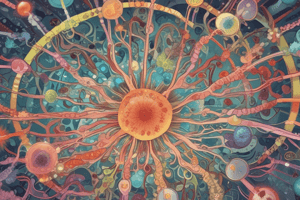Podcast
Questions and Answers
What is the primary reason for the existence of multiple alleles in the MHC genes?
What is the primary reason for the existence of multiple alleles in the MHC genes?
- To allow the population to deal with the diversity of microbes (correct)
- To increase the expression of class II molecules
- To reduce the expression of class I molecules
- To ensure that each individual has a unique immune response
How are MHC genes expressed?
How are MHC genes expressed?
- X-linked
- Dominantly
- Recessively
- Codominantly (correct)
What is the main function of MHC molecules?
What is the main function of MHC molecules?
- To recognize and eliminate infected cells
- To stimulate B cells to produce antibodies
- To present peptides from microbial proteins to T cells (correct)
- To activate the complement system
Which type of cells primarily express class II molecules?
Which type of cells primarily express class II molecules?
What is the effect of interferon-γ on the expression of class II molecules?
What is the effect of interferon-γ on the expression of class II molecules?
What is the physiologic significance of the different expression patterns of class I and class II molecules?
What is the physiologic significance of the different expression patterns of class I and class II molecules?
What is the main function of the products of genes such as DM, proteasome components, and TAP?
What is the main function of the products of genes such as DM, proteasome components, and TAP?
What is the main difference between Class I and Class II MHC molecules?
What is the main difference between Class I and Class II MHC molecules?
What is the name of the protein associated with the α chain in Class I MHC molecules?
What is the name of the protein associated with the α chain in Class I MHC molecules?
What is the typical length of peptides bound by the peptide-binding cleft of Class I MHC molecules?
What is the typical length of peptides bound by the peptide-binding cleft of Class I MHC molecules?
What type of proteins are Class I and Class II MHC molecules?
What type of proteins are Class I and Class II MHC molecules?
What is the function of the α1 and α2 domains of the α chain in Class I MHC molecules?
What is the function of the α1 and α2 domains of the α chain in Class I MHC molecules?
What is the primary function of dendritic cells in the process of antigen presentation?
What is the primary function of dendritic cells in the process of antigen presentation?
What is the term applied to CD8+ T cells recognizing class I MHC-associated antigens?
What is the term applied to CD8+ T cells recognizing class I MHC-associated antigens?
What is ensured by the restriction of T cell recognition to MHC-associated peptides?
What is ensured by the restriction of T cell recognition to MHC-associated peptides?
Why can MHC molecules be loaded with peptides only inside cells?
Why can MHC molecules be loaded with peptides only inside cells?
What type of T cells recognize class II MHC-associated antigens from the microbe?
What type of T cells recognize class II MHC-associated antigens from the microbe?
What is the primary location of antigen processing and presentation in the context of MHC molecules?
What is the primary location of antigen processing and presentation in the context of MHC molecules?
What is the role of CD4+ helper T cells in the immune response?
What is the role of CD4+ helper T cells in the immune response?
Which cells are responsible for eliminating extracellular microbes?
Which cells are responsible for eliminating extracellular microbes?
What is the role of B lymphocytes in the immune response?
What is the role of B lymphocytes in the immune response?
Which cells are effective against intracellular viruses and other pathogens that can survive and replicate in the cytoplasm of host cells?
Which cells are effective against intracellular viruses and other pathogens that can survive and replicate in the cytoplasm of host cells?
What is the result of protein antigens of microbes entering the class I MHC pathway of antigen processing?
What is the result of protein antigens of microbes entering the class I MHC pathway of antigen processing?
Which cells are responsible for ingesting protein antigens of microbes?
Which cells are responsible for ingesting protein antigens of microbes?
What is a possible outcome when a protein antigen is presented to an individual?
What is a possible outcome when a protein antigen is presented to an individual?
What type of T cells recognize class I MHC-peptide complexes?
What type of T cells recognize class I MHC-peptide complexes?
What strategy do viruses use to evade the adaptive immune system?
What strategy do viruses use to evade the adaptive immune system?
What is the main function of antigen-presenting cells (APCs)?
What is the main function of antigen-presenting cells (APCs)?
What is the final step in the class II MHC pathway?
What is the final step in the class II MHC pathway?
What is the purpose of the TAP protein in the class I MHC pathway?
What is the purpose of the TAP protein in the class I MHC pathway?
Flashcards are hidden until you start studying




